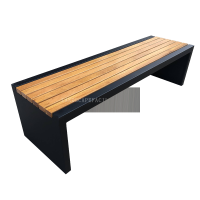Welcome to the website for landscape facilities products and knowledge.
How does the choice of under-counter supports (e.g., legs, brackets) affect the stability of a landscape bar counter?
The choice of undercounter supports is the fundamental, often unseen, determinant of a landscape bar counter's long-term stability and safety. This decision directly influences the counter's resistance to sagging, wobbling, and outright failure under load. The primary options—legs, brackets, and corbels—each impart distinct performance characteristics based on their material, design, and installation method.
Legs, typically constructed from metal or solid wood, provide point load support. Their effectiveness is a function of their quantity, thickness, and placement. A configuration with too few legs, or legs spaced too far apart, creates unsupported spans where the countertop is susceptible to flexing and eventual cracking, especially under heavy appliances or leaning weight. The rigidity of the leg itself is also critical; a thin, hollow metal leg may buckle, whereas a solid, thick leg offers superior compressive strength.
Brackets and corbels, conversely, offer distributed support by anchoring directly to a wall or a sturdy base frame. A well-installed heavy-duty steel bracket system can create a highly stable, "floating" effect by transferring the counter's load efficiently to the wall studs. The stability here is wholly dependent on the bracket's weight rating and the integrity of its attachment to a structural wall. For freestanding or peninsula-style counters, a hybrid approach using a combination of sturdy legs at the free end and robust brackets along the wall is often the most effective solution for preventing lift and sway.
Material selection further compounds these effects. A dense stone countertop like quartz or granite imposes a much greater dead load than a butcher block slab. Supports adequate for a wood top may be dangerously insufficient for stone, necessitating thicker brackets, more legs, or a reinforced substructure. Furthermore, the design of the bar counter influences the choice; a counter with a significant overhang or a built-in breakfast nook requires specialized support, such as heavy-duty cantilevered brackets or a reinforced leg assembly, to counteract the substantial leverage and torque exerted on the connection points.
Ultimately, achieving optimal stability is an engineering exercise. It requires matching the support system's capacity—both in strength and configuration—to the countertop's material, dimensions, design, and intended use. Neglecting this critical calculation risks a shaky, unreliable surface, while a properly supported bar counter becomes a durable and steadfast centerpiece for any space.
Related search:

Recommendation
Modern Stainless Steel Begonia Wood Park Chair Outdoor Courtyard Leisure Sun Protection Bench Long Seat